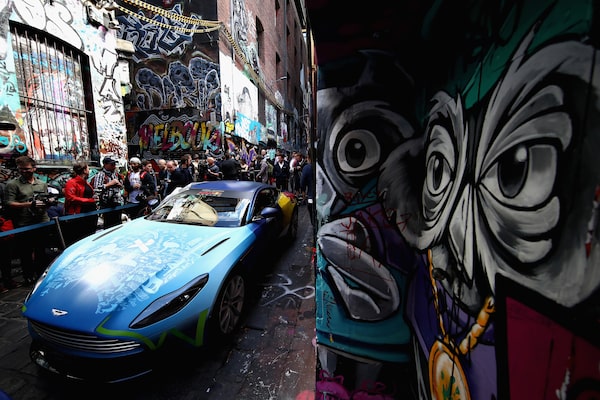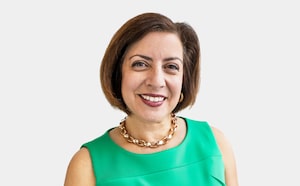Laura Schwab, president of Aston Martin of the Americas, appears at the official opening of the five-floor Grand Touring Automobiles dealership in Toronto on May 31, 2018.Galit Rodan/The Globe and Mail
Laura Schwab, 44, is president of Aston Martin the Americas. Her down-to-earth demeanor and unconventional leadership style is helping to drive the British marquee record sales growth. But her rise to the top of the male-dominated auto world didn’t come without pitfalls. Schwab, who grew up in Kentucky, discussed her personal journey, and Aston Martin’s ambitious Second Century Plan at the official opening of Grand Touring Automobiles, a five-floor dealership that’s home to Aston Martin and six other luxury brands, in Toronto.
Were you a car girl growing up?
I wasn’t. I was a sports girl. I loved sports since I was a kid. As a three-year-old, I would sit on my dad’s lap, watch baseball and steal sips of his drink. I begged my parents to play tennis because they played tennis and I wanted to be like them. I was obsessed with tennis and all sports. I really didn’t fall in love with cars until I fell into the car business.
How did you fall into the car business?
I went to the University of Notre Dame on a tennis scholarship. I was captain of the team in my senior year and, like anyone who doesn’t know what to do with a government and Spanish degree, I went to law school at the University of Kentucky. After I graduated from law school I started practising law; I was a contract lawyer. I’m 24 and I realized this is not for me … I had friends in Southern California and I used their address and started applying for jobs in California – I had no experience. I lost jobs because I sounded too southern.
I got an interview in San Diego with a digital startup company in the late 1990s. They sold cars online – they built configuration technology and had a reverse auction marketplace. I’m thinking – there’s no way I’m getting this job. I know nothing about cars. I know nothing about the internet. I got a law degree. I went to leave and the CEO who interviewed me told the HR manager don’t let her get to the door. I was the 11th employee. We were going to go public and I was going to be a multimillionaire by age 26, which clearly did not happen.

The new Startech Aston Martin DB11 is unveiled during a media day at the 88th Geneva International Motor Show on March 7, 2018.Cyril Zingaro/The Associated Press
And then you end up at Land Rover – that’s a big jump?
I had worked with a guy, who had been a mentor, and he had a job at Land Rover. He said, ‘If you’re lucky, I can get you a job at Land Rover.’ They have a website, but there’s no configurator on it. They want to presell cars online and they need a project manager. You’re the only person I know that can actually do this job. So I went to an interview. It wasn’t a full-time job; it was a contract. I got the job and I wrote my contract for employment. So when my parents said I never used my law degree, they’re actually wrong. I used it once in my life and it was my first contract for employment at Land Rover. And that’s how I got my foot in the door at a manufacturer.
Was it hard to fit in at Land Rover?
The first year or so was hard because I wasn’t a full-time employee. I looked like a little kid back then. I was 26. I was told to get a project team together with a timeline for the configurator. I got this team together, introduced myself as the project manager for the configurator and preselling online program, and this guy looked at me and said, ‘What could you possibly know about any of this? You basically look like you’re 12.’ I finished the meeting, got in my car, drove to Taco Bell, I had two Nacho Bellgrandes and a large drink and I cried. Then I went back and went right up to him and said you’re going to be part of this project because I actually need you. And I do know what I am talking about.
You moved up the ranks fast becoming the marketing director for Jaguar Land Rover in Britain – how was that transition as a woman and foreigner in a new country?
I was living in New York at the time. I packed my bags and left. I landed in Heathrow, looked out the window and thought, ‘What the hell have I done to myself? I’ve got to drive on the other side of the road. I don’t know anybody.’ I underestimated the transition, culturally. I wasn’t going to be living in London where there are lots of Americans. I was out in the Midlands, one of few female directors with, apparently, an American accent. That was really hard at first. I felt like I didn’t fit in. It took me a good year before I fit in.
’What was hard in my career was looking for other female role models. It was hard not having female role models. I had to believe in myself and create my own personality. I’m a bit unconventional.’Galit Rodan/The Globe and Mail
How do you end up at Aston Martin?
I was working in the U.K. for almost five years for Jaguar Land Rover – I loved it. And the chief marketing officer for Aston Martin is a friend of mine, a guy named Simon Sproule. We had worked in California and after all these years, he contacted me. We were both situated in the Midlands. He asked would you want to come and see the Aston Martin factory? Who is going to say no to that?
The morning of the factory tour, I was going to Lord’s Cricket for a cricket match. I had never been to a cricket match. I wore all white because cricket players wear white and that must be what everyone wears when they watch, which clearly is not the case. I drink a few glasses of champagne and then take the train to the factory. I walk in and meet up with Simon. He starts explaining how the cars are handcrafted, how they take 250-300 hours to hand-build, and how the badge in the front is a piece of jewelry made in the jewelry district in Birmingham. I was blown away.
And then, Simon says, ‘Here’s our CEO, Andy Palmer’. I’m so casual. Andy starts telling me about the Second Century Plan and his vision for Aston Martin. And he said, we would like you to consider coming to work for Aston Martin – we want you to be president of Aston Martin the Americas. I said, ‘Oh wait. This is a job interview? I’m not looking for a job.’ I go home and tell my husband, who is British. He looked at me and said, ‘That is the coolest blankin’ job in the world. Sounds like we’re moving to the United States.’ He didn’t skip a beat. Didn’t say we need to think about it. My husband is an important and crucial part of my life and my success.
Looking back, what’s the biggest challenge you faced in your career?
I got pregnant five weeks after I started my job at Aston Martin. I wasn’t that young [42]. I had to call Andy Palmer and tell him I’m pregnant. The company was amazing. But I went through all of this guilt. Are they going to be disappointed that they hired me? Then I had flashbacks. I had lots of women work for me and they got pregnant – did I ever make them feel badly? Was I supportive?
What was hard in my career was looking for other female role models. It was hard not having female role models. I had to believe in myself and create my own personality. I’m a bit unconventional.

An Aston Martin DB11 sits parked before the Australian Formula One Grand Prix at Albert Park on March 21, 2018 in Melbourne.Clive Mason
Has your husband and daughter made you a better leader?
My whole life, I was convinced there was no room for anyone else in it. If someone wants to come along for the ride, great. But I had to stay focused. On paper, guys thought I was great – loves sports, loves cars, doesn’t want to text often. But Nick is the first person I felt truly understood where work fit for me. He made me step away from it, which is good. Once I met him, I didn’t want to sit and work all weekend – the people who work for me don’t want to get e-mails from me on Saturday and Sundays. I didn’t think there was anything I was looking for until I met him.
What’s in store for Aston Martin’s future?
We’re knee-deep in our Second Century Plan – seven cars in seven years. It started when we launched the DB11 in 2016. Then we introduced the V-8 versions with the V12. The Volante, which is the most beautiful convertible I’ve ever seen, is just about to go on sale now. The Vantage goes on sale this summer. Then in the fall, we introduce the DB11 V12 AMR. We are also getting ready to reveal the DBS Superleggera, the replacement for the Vanquish at the top of the range, later this year. It’s a pretty active 2018. That’s unparalleled in the automotive world. We’ll reveal the SUV next year and it’ll go on sale in 2020.
But aren’t you late to the party with your SUV?
No. I think the timing is perfect. Sometimes being first is really hard as well. There’s a lot to learn from what our competitors have done – what works and what doesn’t work. So the timing is perfect. It was crucial to get the core products right. That’s our core focus first and then it’s about how we expand our portfolio. We’re really getting the business right. It’s the most loved and coolest brand in the world.
Sign up for the weekly Drive newsletter, delivered to your inbox for free. Follow us on Instagram, @globedrive.
 Petrina Gentile
Petrina Gentile